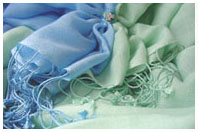About Pashmina
Exclusive handloom and the finest mountain goats make our products wool, which can only be found in the higher altitude mountain areas of Nepal and Tibet. This is one of the softest and smoothest wools in the world.

PASHMINA, from the Persian word for wool, is popularly known in the west as CASHMERE wool (a common mistake), from the old spelling for Kashmir. The fine wool comes from the undercoat of the Himalayan mountain goat (scientific name Ibex). For over a thousand years pashmina has been woven into shawls and blankets, prized by royalty and common people alike for its otherworldly softness, warmth, and long life. For many centuries Kashmir was the only place the fiber could be woven into shawls, according to treaties that gave the Maharaja of Kashmir exclusive rights to Tibet’s pashmina (CASHMERE) supply. Today most of the world’s pashmina shawls are woven on handlooms in Nepal’s Kathmandu Valley. And most are woven on a warp of spun silk for increased suppleness and strength. In recent years this silk and pashmina blend has become very popular in the western fashion world. The pashmina yarn is so fine that it requires a length of 3 km to weave a small shawl. In other words, it takes the annul growth of 1-7 goats per shawl.
If you were to compare the fineness of the ibexes throat hair to a humans, a humans hair measure aprox. 50 microns while a pashmina hair is only 14-15 microns.
DIFFERENCE BETWEEN PASHMINA AND CASHMERE
Pashmina is made from the hair of the under throat and belly of the high mountain goats that reside over 4,000 meters. The hair here is especially soft and due to the high altitude cold it is exceptionally fine and warm.
Pashmina has been called "the jewelry of fiber goods" due its high quality. There is a lot of competition between cashmere and pashmina because of their similarities but there are definite differences.
|
| Pashmina |
Cashmere |
- Only made from the under hair of high altitude mountain goats.
- Has a finer texture than cashmere.
- Since it is only the fine under hair it is difficult to make into threads.
- The size ranges from 10-16 microns.
- Since it includes only the soft hair under throat and belly one can only get aprox. 80 grams from each goat so it is harder to find.
|
- Made from the entire body hair of regular mountain goats.
- Has a rougher texture than pashmina.
- Since include entire coat hair of goat it is easier to make into thread.
- The size ranges between 16-19 microns.
- Since it includes the goat’s entire coat there is more availability.
|
Pashmina is a very sensitive product so you need good craftsmanship to get what you call a good Pashmina.
There are many people involved in making just one shawl; from the shearing, through spinning the threads, weaving, dying, and so forth.
If just one of these people makes a mistake, (i.e. the thread to thick, thin, or uneven) then the entire shawl is either ruined or of lower quality.
For Current Web Prices, see our Pashmina Pricing Chart - guaranteed lowest price!



